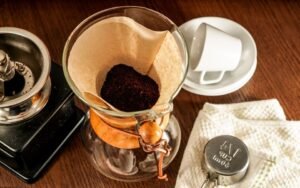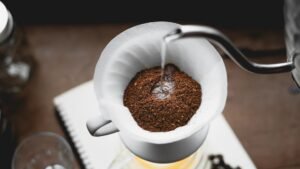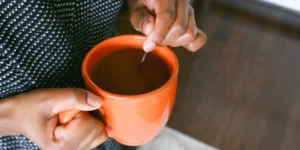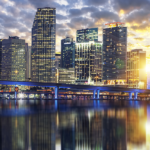Making a perfect cup of drip coffee is an art that requires attention to detail and an understanding of the brewing process. This guide will walk you through everything you need to know to brew an excellent cup of drip coffee, from selecting the right beans to perfecting your brewing technique.
How to Make a Perfect Cup of Drip Coffee
Ingredients
- Freshly roasted coffee beans (preferably whole beans)
- Filtered water
Equipment
- Drip coffee maker
- Coffee grinder (burr grinder preferred)
- Coffee filter (paper or reusable)
- Measuring spoon or kitchen scale
- Timer
- Thermometer (optional)
Selecting Your Coffee Beans

- Choose Freshly Roasted Beans:
- The quality of your coffee starts with the beans. Look for freshly roasted beans from a reputable source. The roast date should be within two weeks of purchase for the best flavor.
- Opt for whole beans instead of pre-ground coffee to preserve freshness.
- Consider the Roast Level:
- Light roast: Bright and acidic, showcasing the coffee’s origin flavors.
- Medium roast: Balanced, with a mix of acidity and body.
- Dark roast: Bold, with deep, roasted flavors and lower acidity.
- Select Your Origin:
- Single-origin beans offer unique flavors from specific regions, such as Ethiopian beans with fruity notes or Colombian beans with a nutty profile.
- Blends provide a balanced and consistent flavor, combining beans from multiple regions.
Grinding Your Coffee
- Use a Burr Grinder:
- A burr grinder produces a consistent grind size, essential for even extraction. Blade grinders can create uneven particles, leading to over-extraction and bitterness.
- Grind Size:
- For drip coffee, aim for a medium grind, similar to the texture of granulated sugar. This allows for optimal extraction during brewing.
- Measure Your Coffee:
- Use a kitchen scale for precision. The standard ratio is 1:15 to 1:18 (coffee to water). For example, 1 ounce (28 grams) of coffee to 15-18 ounces (425-510 grams) of water.
Preparing Your Water

- Use Filtered Water:
- Water quality significantly affects coffee flavor. Use filtered water to avoid impurities that can alter the taste.
- Water Temperature:
- The ideal brewing temperature is between 195°F and 205°F (90°C to 96°C). Too hot, and you’ll extract bitter compounds; too cool, and the coffee will be under-extracted and weak.
- If your coffee maker doesn’t have a temperature control, let the water sit for 30 seconds after boiling to reach the optimal range.
Brewing Process
- Prepare Your Coffee Maker:
- Ensure your drip coffee maker is clean. Residual oils and coffee particles can affect the taste of your brew.
- Place a clean coffee filter in the basket. Rinse the paper filter with hot water to remove any paper taste and preheat the coffee maker. Discard the rinse water before brewing.
- Add Coffee Grounds:
- Measure the ground coffee based on your preferred coffee-to-water ratio. For a standard 8-cup (40-ounce) coffee maker, use approximately 2.5 ounces (70 grams) of coffee.
- Add the ground coffee to the filter basket, leveling it out for even water distribution.
- Start Brewing:
- Pour the filtered water into the coffee maker’s reservoir. Ensure you use the correct amount based on your coffee-to-water ratio.
- Turn on the coffee maker and start the brewing process. The hot water will pass through the grounds, extracting flavors and aromas into the carafe.
- Monitor the Brew Time:
- The total brewing time should be between 4 to 6 minutes. If it takes longer, your grind might be too fine; if it’s faster, the grind might be too coarse.
Enhancing the Flavor
- Stir the Coffee:
- After brewing, give the coffee a gentle stir in the carafe to mix the flavors evenly, especially if brewing a larger batch.
- Serve Immediately:
- Pour the coffee into your mug and enjoy it while it’s fresh and hot. Coffee’s flavor diminishes as it sits, so avoid leaving it on the hot plate for too long.
Customizing Your Coffee
- Adjust Strength:
- If you prefer stronger coffee, increase the coffee-to-water ratio. For a milder brew, decrease the amount of coffee.
- Additions:
- Customize your coffee with milk, cream, sugar, or flavored syrups. Experiment with spices like cinnamon or cardamom for a unique twist.
- Cold Brew Option:
- To make a cold brew, use a coarser grind and steep the coffee grounds in cold water for 12-24 hours. Strain and serve over ice for a smooth, refreshing drink.
Cleaning and Maintenance
- Clean After Each Use:
- Rinse the carafe, filter basket, and any removable parts after each use to prevent the buildup of coffee oils and residue.
- Descale Regularly:
- Descale your coffee maker every 1-3 months, depending on usage and water hardness. Use a descaling solution or a mixture of equal parts water and white vinegar. Run a brewing cycle, then flush with clean water.
Troubleshooting Common Issues

- Bitter Coffee:
- Possible causes: Over-extraction, too fine grind, or too hot water.
- Solution: Use a coarser grind, check water temperature, and ensure brewing time is within 4-6 minutes.
- Weak Coffee:
- Possible causes: Under-extraction, too coarse grind, or not enough coffee.
- Solution: Use a finer grind, increase the amount of coffee, and check brewing time.
- Off-Flavors:
- Possible causes: Dirty equipment, poor-quality water, or stale coffee beans.
- Solution: Clean the coffee maker regularly, use filtered water, and ensure coffee beans are fresh.
Variations of Drip Coffee
- Single-Serve Machines:
- Single-serve machines, like Keurig, offer convenience and variety. Use quality pods and ensure the machine is clean for the best flavor.
- Manual Drip (Pour Over):
- A manual drip method, like a Chemex or V60, gives you more control over the brewing process. Pour hot water over the grounds in a circular motion, allowing for even extraction.
- Cold Brew Drip:
- Use a cold brew drip tower for a slow extraction over several hours. This method produces a smooth, concentrated coffee that can be served cold or diluted with water or milk.
FAQs
Q: How can I keep my coffee hot without burning it?
A: Transfer brewed coffee to a thermal carafe to keep it hot without burning. Avoid leaving it on the hot plate, as this can make the coffee taste bitter.
Q: What’s the best way to store coffee beans?
A: Store coffee beans in an airtight container in a cool, dark place. Avoid refrigerating or freezing them, as moisture can affect the beans’ quality.
Q: Can I reuse coffee grounds?
A: It’s not recommended to reuse coffee grounds for brewing, as they will be over-extracted and result in a weak, bitter brew. However, used grounds can be repurposed for gardening or as a natural deodorizer.
Q: How much coffee should I use for a full pot?
A: For a standard 12-cup (60-ounce) coffee maker, use about 4 ounces (113 grams) of coffee. Adjust based on your taste preference and coffee-to-water ratio.
Q: Why does my coffee taste sour?
A: Sour coffee is often a sign of under-extraction. Ensure the water temperature is within the optimal range and use a finer grind if necessary.
Nutritional Information (Per Serving)
- Calories: 2 (without additions)
- Carbohydrates: 0g
- Protein: 0g
- Fat: 0g
- Sugar: 0g
- Caffeine: Approximately 95mg per 8-ounce cup
Conclusion
Brewing the perfect cup of drip coffee is a combination of selecting quality ingredients, mastering the right techniques, and personalizing the process to your taste. By paying attention to the details—such as the freshness of your beans, the precision of your grind, the quality of your water, and the accuracy of your brewing time—you can elevate your daily coffee ritual to an art form.
Experiment with different beans, grind sizes, and brewing methods to discover what suits your palate best. Whether you enjoy a robust dark roast or a bright and acidic light roast, the journey to the perfect cup of drip coffee is a rewarding experience that enhances both flavor and appreciation for this beloved beverage.
Take the time to savor each cup, and don’t be afraid to make adjustments and try new variations. With practice and patience, you’ll become adept at brewing a consistently excellent cup of drip coffee that meets your personal standards of perfection. Enjoy the process and the rich, aromatic results!








